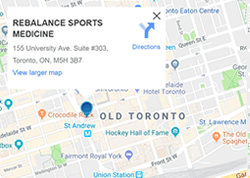Proprioception: Why physiotherapists always make us balance
 Proprioception also known as position sense is our bodies ability to tell where it is in space relative to the rest of the body without looking at it and how/where parts of our body are moving. It is what tells us for example if our elbow is bent or straight or if our foot is directly underneath the knee or it if is out to the side. It guides us to put our sock on our foot or to bring food to our mouth without looking at our limbs. In one of the most common injuries of an ankle sprain, proprioception tells us when we start to go over on our ankle and then (hopefully) we can correct it in time to prevent going fully over the ankle.
Proprioception also known as position sense is our bodies ability to tell where it is in space relative to the rest of the body without looking at it and how/where parts of our body are moving. It is what tells us for example if our elbow is bent or straight or if our foot is directly underneath the knee or it if is out to the side. It guides us to put our sock on our foot or to bring food to our mouth without looking at our limbs. In one of the most common injuries of an ankle sprain, proprioception tells us when we start to go over on our ankle and then (hopefully) we can correct it in time to prevent going fully over the ankle.
In our muscles, joints, ligaments and tendons we have little sensors that detect joint position and movement. Muscle spindles, golgi tendon organs, joint receptors and mechanoreceptors, to name a few, work together to give us this information. If your hamstring gets rapidly stretched these sensors detect this quick stretch and will reflexively tell our body to intervene to avoid getting over stretched and injured.
Let’s think back to the ankle sprain and move on to why physical therapists always give balance exercises after injury. If our system is delayed or the movement is just too quick and we go over on our ankle and sprain it, soft tissue structures get injured. The muscle, tendon, ligament, and joint integrity gets disrupted and this affects the sensors in these tissues that provide us proprioception. After injury suddenly it is much harder to balance on that foot then it is to balance on the non injured foot. The sensors no longer know exactly where it is in space or how it is moving. This has to be ‘recalibrated’ and that’s where balance exercises come in.
Slow progression of balance exercises allow us to retrain those sensors to be able to control the joint.If you don’t retrain your balance or proprioception you are at a much greater risk of re-spraining that ankle. If you start to go over again on your ankle and haven’t retrained the sensors your body will likely detect too late that you are going over on the ankle and re-injury occurs. The progression of exercise is important as well because if you just train balance on a stable flat ground your sensors will get good at detecting position sense on flat ground but it won’t retrain position sense when you are on an uneven beach, when you are running on a soccer field, or when you are trying to make your way to the bathroom in the dark.
Get some guidance if you’ve been injured and need help re-training your proprioception specific to the things you need to be able to do. But here are some common balance progression exercises to practice.
- Balancing on one leg
- Balancing on one leg with eyes closed
- Balancing on one leg while turning your head to look over your shoulder from side to side
- Balancing on one leg while kicking the other leg in front, out to the side and back
- Balancing on one leg and doing an ‘airplane’, tilting forward at the hips until your body is parallel to the ground and then returning to single leg balance without touching down
- Balancing on an uneven surface: Bosu ball, wobble board, a couch cushion or pillow
- Then repeat all of the above on the uneven surface first with eyes open, then with eyes closed
Balance, and thus proprioception, like most things get better with practice and repetition. It’s a skill that has to be relearned after injury. Happy Balancing!
Bonnie Winship, Physiotherapist
Bonnie Winship is a registered physiotherapist practicing at Rebalance Sports Medicine in downtown Toronto.



 What to Expect From Your First Physiotherapy Visit
What to Expect From Your First Physiotherapy Visit The Benefits of Fascial Stretch Therapy [Demo]
The Benefits of Fascial Stretch Therapy [Demo] How Does Physiotherapy Work?
How Does Physiotherapy Work? Best Exercises for Low Back Pain
Best Exercises for Low Back Pain